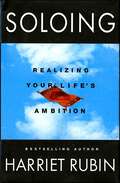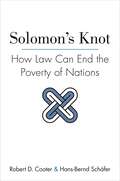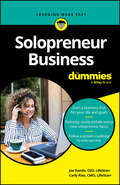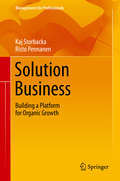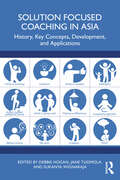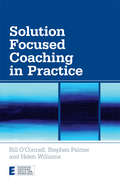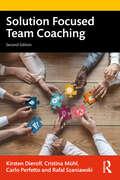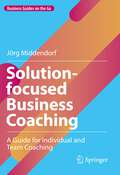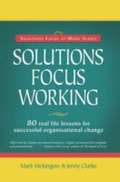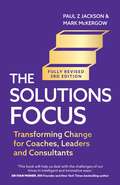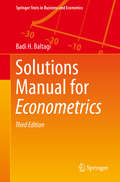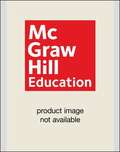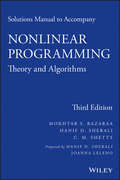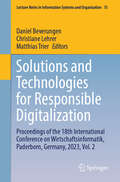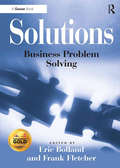- Table View
- List View
Solo: How to Work Alone (and Not Lose Your Mind)
by Rebecca Seal&“Kind, realistic, and genuinely helpful...Install a copy on whatever surface is functioning as your desk, and you may even feel a little bit less alone.&” —The Observer (London) A practical, accessible, and charming guide for finding joy while navigating your professional life working remotely from home—without losing your mind.Like it or not, working alone is now the new normal. The COVID-19 pandemic may have accelerated the process, but the trend is clear—making a living outside the confines of a public workplace is here to stay. For anyone who needs guidance on how to navigate working from a home office—or a home sofa—here is a charming, expert, and genuinely helpful guide to managing a productive career without impromptu hallway conversations or on-call IT support, but with more joy—and, for most of us, better coffee. Written by a dedicated work-from-home expert, Solo culls wisdom from the latest research in psychology, economics, and social science and explores what we gain, or lose, in the shift to solo work. In chapters like &“Loneliness and Solitude,&” &“The Power of Planning,&” and &“The Curse of Comparison (and Why Social Media Sucks),&” it picks up where the bibles for freelancers stop, offering practical, inspiring, and uniquely reassuring advice culled from a range of influences, from Aesop&’s fables to medical journals, and explaining what helps us stay resilient, productive, and focused in a company of one.
Soloing: Realizing Your Life's Ambition
by Harriet RubinSoloing has two meanings: "going it alone" and being "complete in yourself." . . . But you don't just leave--a company/a career/a paycheck--and cross over to a more satisfying life. There's more to it. There is a mysterious passage to be negotiated, a delicate transition required to go from alone-in-the-desert to complete-in-yourself.Harriet Rubin, bestselling author of The Princessa: Machiavelli for Women, returns with inspiring advice for professionals dreaming of crossing over from a corporate world of prescribed boundaries to the limitless opportunities of soloing. She describes how people can do great things--things they would never be able to accomplish inside the corporate structure--when they manage or lead no one.As one successfully navigates the passage toward a truer sense of self that Rubin describes, four invaluable freedoms await:The first freedom is regaining your sense of identity.Walk out of any big company and who are you, stripped of that mighty identity? Potentially bigger and better than before. Who were you before the corporate you? To get back one's sense of self is why people go solo.The second freedom is independence.Why is working alone so important in doing great work, given that it's also the scariest part? Imagine having complete command and control over your time and the work you do. This is how soloists realize their great strengths: They are reduced to themselves.The third freedom is income.You can earn in one year what you earned in two before. Do you work harder to do this? Yes. Do you enjoy it more? Yes. Solo money is alive. Unlike a salary doled out like an allowance from parents, the money earned by soloing is a true emblem of a person's worth.The fourth freedom is illumination.A professional builds a career, but a soloist builds a portfolio and a life free of boredom, full of challenge. Direct contact with work itself is direct contact with life.With insights as diverse as Henry David Thoreau's "I want to be sure the world doesn't change," and Michael Jordan's response to the statement: "There's no 'I' in team,"--"That's right, but there is an 'I' in win,"--Rubin gives readers the chance to bring their dreams into alignment with reality.
Solomon's Knot: How Law Can End the Poverty of Nations (The Kauffman Foundation Series on Innovation and Entrepreneurship #9)
by Robert D. Cooter Hans-Bernd SchäferWhy law is critical to innovation and economic growthSustained growth depends on innovation, whether it's cutting-edge software from Silicon Valley, an improved assembly line in Sichuan, or a new export market for Swaziland's leather. Developing a new idea requires money, which poses a problem of trust. The innovator must trust the investor with his idea and the investor must trust the innovator with her money. Robert Cooter and Hans-Bernd Schäfer call this the "double trust dilemma of development." Nowhere is this problem more acute than in poorer nations, where the failure to solve it results in stagnant economies.In Solomon's Knot, Cooter and Schäfer propose a legal theory of economic growth that details how effective property, contract, and business laws help to unite capital and ideas. They also demonstrate why ineffective private and business laws are the root cause of the poverty of nations in today's world. Without the legal institutions that allow innovation and entrepreneurship to thrive, other attempts to spur economic growth are destined to fail.
Solopreneur Business For Dummies
by Joe Rando Carly RiesCreate and run your one-person business with pro advice and strategic tools Solopreneur Business For Dummies offers advice and tools to create, grow, and manage your business when you're going it alone. Unlike entrepreneurs, solopreneurs typically create their businesses to serve their lives—instead of trying to scale as much as possible. To thrive in this lifestyle, you'll need to understand the basics of business operations, financial management, sales, and marketing. You'll also need to learn how to do all these things without burning yourself out. This book has you covered in all those areas. You'll also learn how to create a support network that offers guidance, emotional support, and business opportunities. Set your business up for success with this no-nonsense Dummies guide. Build a successful business from the ground up—without employees Avoid the common mistakes that derail many new businesses Develop a viable business idea that aligns with your personal goals and your desired lifestyle Learn the best practices from the big guys, tailored for a one-person business Discover tech tools that can make it easier to run your business Learn from the stories of successful solopreneurs across industries Solopreneur Business For Dummies is a practical and easy-to-understand resource that makes it easy to start your own solo venture. Get the tools and insights you need to navigate the challenging yet rewarding path.
Solution Business
by Kaj Storbacka Risto PennanenSuccess in solution business starts by accepting that solution business is a separate business model, not simply another product category or an extension of the existing product business. This book identifies the business model areas that firms need to focus on when transforming into solution business. It further organizes these areas into three sets of capabilities and practices: commercialization, industrialization and solution platforms. This is the first book to take a comprehensive view of success in solution business and its relevance therefore extends to all functions of firms wanting to become solution providers as well as to many managerial levels. The book will also help you self-assess how ready your organization is for success in solution business.
Solution Focused Coaching in Asia: History, Key Concepts, Development, and Applications
by Debbie Hogan Jane Tuomola Sukanya WignarajaThrough inspiring stories illustrating the diverse application of coaching within Asian contexts, this data-rich volume dives into the theory and practice of Solution Focused coaching offering numerous tools and techniques that can be used immediately. With the rising demand for coaching across Asia, there is a need for coaches to have access to up-to-date practice-based evidence of its effectiveness. The Solution Focused approach, as a social-constructionist approach, privileges the clients’ experience, resources, and preferred future over an 'analytic' or deficit-oriented stance. Contributors analyse real case examples from many countries across Asia including Singapore, Malaysia, Indonesia, China, Taiwan, Hong Kong, Japan, Cambodia, and Sri Lanka. Practical in its approach, the book offers new insights into established areas of coaching and also highlights innovations in coaching in areas where Solution Focused coaching and other models have not reached until recently. These areas include health and wellness coaching for medical compliance needs, faith-based coaching, and coaching incarcerated fathers.This is an essential and comprehensive resource that is written for both beginner and experienced coaches and addresses the need for effective and culturally sensitive coaching models in Asia. It will also be beneficial for managers and health care professionals looking to enhance their work through coaching skills.
Solution Focused Coaching in Practice (Essential Coaching Skills and Knowledge)
by Stephen Palmer Helen Williams Bill O'ConnellSolution Focused Coaching in Practice is a practical 'how-to' guide that provides an invaluable overview of Solution Focused Coaching skills and techniques. Reflecting upon published research on the solution focused approach, Bill O'Connell, Stephen Palmer and Helen Williams bring their own experiences of Solution Focused Coaching together with others in the field to cover topics such as: the coach-coachee relationship the role of technology in coaching inclusive coaching group and team coaching practical issues and skills. Incorporating coachee case studies, worksheets, practice tips and discussion points, the skills, strategies and techniques in this book are straightforward to apply and can be used in most coaching settings. This practical book is essential reading for experienced personal or executive coaches, managers considering introducing a new and better coaching culture for their staff, and for those just starting out on their coaching journey.
Solution Focused Team Coaching
by Kirsten Dierolf Cristina Mühl Carlo Perfetto Rafal SzaniawskiSolution Focused Team Coaching offers readers a simple, practical and effective way to coach teams. Its evidence-based approach, which has been applied successfully to many fields, is presented in an engaging, pragmatic and approachable way, making this book a must read for anyone who wants to broaden their horizon within the team coaching space. This book presents the background and philosophy of Solution Focused team coaching and then moves on to explore its practical application in various formats of team coaching, with different audience dimensions. The reader will find a useful structure for team coaching processes as well as detailed descriptions for facilitating team coaching “moves” (conventionally called “techniques” or “tools”) for both online and live settings. With this book, it is easy to plan a Solution Focused team coaching process from contract negotiation through workshop design to follow-up and evaluation. It covers difficult team situations such as conflicts, and different forms of teams from shop-floor to executive teams, Agile teams and special formats of team coaching, as well as how to facilitate larger teams. Additionally, readers who want to achieve certification and/or accreditation will find it extremely useful to read about ICF, EMCC and AC team coaching competencies and how Solution Focused team coaching is an easy way of embedding those competencies. Solution Focused Team Coaching is a must for any coach, from those who would like to learn a pragmatic, impactful and easy way to move into team coaching to experienced team coaches who would like to learn a new approach and expand their skills, and anybody interested in exploring the fascinating world of team coaching.
Solution Mining: Leaching and Fluid Recovery of Materials
by Robert BartlettFirst published in 1998. This book offers a wealth of information on the rapidly expanding field of solution mining: yhe extraction of materials from the earth by leaching and fluid recovery. This is an introductory text for students and professional engineers that is comprehensive and emphases current practice and theory. Percolation leaching of fragmented ground is covered, as well as true and modified in situ teaching. Solution mining of gold, copper and uranium ores, several slats extracted from evaporates and brines, and sulfur are discussed. Mineral teaching chemistry and kinetics, hydrology (including flow equations for various wellfields and other fluid recovery systems), environmental containment and solution mining simulation models are also included.
Solution-focused Business Coaching: A Guide for Individual and Team Coaching (Business Guides on the Go)
by Jörg MiddendorfThis book presents the fundamentals and applications of solution-focused coaching both in individual coaching and in coaching entire teams. It provides central tools for consulting as well as an extensive collection of solution-focused coaching questions for practical use. In the second part of the book, methods and procedures for conducting team coaching workshops are presented. The book is aimed primarily at coaches and consultants who want to enrich their work with solution-focused coaching, as well as managers especially in the field of human resource management.
Solutions Focus Working: 80 Real Life Lessons for Successful Organizational Change (Solutions Focus at Work Series)
by Mark Mckergow Jenny ClarkeFourteen organisations all over the world tell the stories of how Solutions Focus has helped them to change - and show you many ways to find what works in the workplace. organisational change simple. The fourteen real life cases described here illustrate the Solutions Focus approach in action from widescale change to everyday effective management, e.g. British Sky Broadcasting, Bayer Cropscience, the Cooperative Group, the Ontario Medical Association and Freescale Semiconductor. They worked on issues including restructuring, strategy development, sales improvement, continuous improvement, team development, outplacement, training and job satisfaction. Jenny Clarke guides you through the ins and outs of each case, and draws 80 lessons which you can use in building positive change at work and keeping things as simple as possible - but no simpler.
Solutions Focus, 3rd edition: Transforming change for coaches, leaders and consultants
by Mark McKergowSolutions Focus Practice is transforming coaching, consulting and leadership in organisations all over the world. A powerful yet simple approach to positive change, a solutions focus approach to people problems explores what works in a given situation and aims do more of it.The Solutions Focus is the definitive guide to this revolutionary yet practical alternative to conventional wisdom. It demonstrates how the unique SIMPLE method of working sidesteps the search for the causes of trouble and heads directly for the solution. Today national solutions focus associations around the world from Sweden to Australia, base their training on the methods explained here. Solutions focus is in widespread use by consultants, coaches, facilitators and managers. It can be applied at one-to-one, group or organisational levels. Applications include health and wellbeing, sales and negotiation, team building and leadership, performance management, organisational strategy and even peace-building and climate resilience. This long-awaited new edition of The Solutions Focus is fully revised and updated for today's executive, career and life coaches. Including the transformative OSKAR coaching framework, one of the most used throughout the coaching world. Revisions to this acclaimed book include updates throughout to position it in the contemporary landscape. Next generation developments are fully covered including new research on embodiment and experience, the role of hosting rather than directing, and the importance of detail. New case studies from around the world including Nestle, Kraft, Tate and Canon continue the book's legacy of learning from real cases by looking closely at what happens and how it works. Finally, new material exploring improvisation and co-constructed stories completes the update and will ensure this book remains the leader in its field for generations to come.
Solutions For Sustainability Challenges: Technical Sustainability Management and Life Cycle Thinking
by Wulf-Peter SchmidtThe book is intended as a primary resource for Chief Sustainability Officers (CSOs), all professionals with interest in sustainability as well as sustainability courses at CBS International Business School and other universities. It starts by reviewing the challenges of sustainability (environmental, social, economic, and governance). The basics of life cycle thinking are explained, looking at Life Cycle Assessment/LCA, Life Cycle Costing/LCC, Social LCAs, and Life Cycle Management. These are applied to sustainable strategy development, sustainable product development, sustainable supply chain management and logistics, sustainable production, sustainable consumption, circular economy, sustainable digitalization, sustainable finance, sustainable employee relations, sustainable advocacy, law and policymaking, etc.—to show how each person in each profession and role can act sustainably and how to democratize sustainability.
Solutions Manual for Econometrics
by Badi H. BaltagiThis Second Edition updates the Solutions Manual for Econometrics to match the fourth edition of the Econometrics textbook. It corrects typos in the previous edition and adds problems and solutions using latest software versions of Stata and EViews. Special features include empirical examples using EViews and Stata. The book offers rigourous proofs and treatment of difficult econometrics concepts in a simple and clear way, and it provides the reader with both applied and theoretical econometrics problems along with their solutions.
Solutions Manual to Accompany Essentials of Investments (Ninth Edition)
by Zvi Bodie Alex Kane Alan MarcusRevised by Fiona Chou, University of California San Diego, and Matthew Will, University of Indianapolis, this manual provides detailed solutions to the end-of-chapter problems. There is consistency between the solution approaches in the examples featured within the text and those presented in the manual.
Solutions Manual to Accompany Nonlinear Programming: Theory and Algorithms
by Hanif D. Sherali Mokhtar S. Bazaraa C. M. ShettyAs the Solutions Manual, this book is meant to accompany the main title, "Nonlinear Programming: Theory and Algorithms, Third Edition. " This book presents recent developments of key topics in nonlinear programming (NLP) using a logical and self-contained format. The volume is divided into three sections: convex analysis, optimality conditions, and dual computational techniques. Precise statements of algortihms are given along with convergence analysis. Each chapter contains detailed numerical examples, graphical illustrations, and numerous exercises to aid readers in understanding the concepts and methods discussed.
Solutions and Technologies for Responsible Digitalization: Proceedings of the 18th International Conference on Wirtschaftsinformatik, Paderborn, Germany, 2023, Vol. 2 (Lecture Notes in Information Systems and Organisation #75)
by Daniel Beverungen Christiane Lehrer Matthias TrierThis book is the second volume of proceedings from the 18th International Conference on Wirtschaftsinformatik held in Paderborn, Germany, in 2023. In the context of the global trend toward digitalization, it presents the results of innovative, high-quality research in the field of information systems and digital transformation. The book covers a broad range of topics, including digital innovation, business analytics, artificial intelligence, and IT strategy, each of which has and will continue to have significant impacts on companies, individuals and societies alike.
Solutions for Sustainability: How the International Trade, Energy and Climate Change Regimes Can Help (European Yearbook of International Economic Law)
by Rafael Leal-ArcasThis book explores links and synergies between international trade and two of the most urgent challenges of the 21st century: achieving sustainable energy (i.e., energy that is affordable, secure, and clean) and mitigating climate change. It takes the unique approach of not only examining how international trade can help achieve energy and climate goals, but also the impact of emerging tools and technologies such as smart grids and demand response, and the potential role and impact of citizens and prosumers. The book analyzes energy- and trade-related regulations in a range of jurisdictions to assess how conducive the regulation is towards achieving sustainable energy, and identifies gaps and overlaps in the existing legal framework.
Solutions to Financial Economics: Exercises on Classical and Behavioral Finance (Springer Texts in Business and Economics)
by Thorsten Hens Marc Oliver RiegerThis book offers a concise introduction to the field of financial economics and presents, for the first time, recentbehavioral finance research findings that help us to understand many puzzles in traditional finance. Tailor-made formaster’s and PhD students, it includes tests and exercises that enable students to keep track of their progress. Parts of the book can also be used at the bachelor level.
Solutions: Business Problem Solving
by Frank FletcherThere are some events in life that are inevitable, and the emergence of problems in the workplace is one. Solutions sets out to provide remedies that are accessible, practical, meaningful, and final. Well organized, and referenced to specific operations, this book provides troubleshooting and other assistance, and serves as an encyclopedic reference for answers to organizational problems for managers and practitioners. All the functional activities and operations of organizations are included, so that almost any problem or issue that may occur will be addressed in one or more chapters. Readers will be able to quickly locate, understand and use a specific tool or technique to solve a problem. The different tools available are described, or a single most useful tool indicated. The tool is then explained in depth with an example of how it can be used. The strengths and weaknesses of individual tools are identified and there are suggestions for further help. Solutions is essential for anyone wanting to learn the basics of business problem solving and those who might know the basics but want to expand their understanding.
Solutions: Workplace Answers 911:Revelations For Workplace Challenges and Firefights
by Lynne CurrySolutions offers you strategies, insights, answers and revelations Some are simple, others innovative and surprising--and all ones that can change your work life for the better. Solutions offers you sixty of the best real-life dramas--and enlightening answers from Dr. Lynne Curry's three decade weekly newspaper column run in multiple newspapers. Written by a successful management consultant and coach, Solutions offers you your personal workplace 411/911 written in Curry's warm, personal, enlightening and fun style. You Need a Solution When: You face a problem or challenge that doesn't solve easily Your work life is good--you want it to be great You want excellence or more than what comes easily You can't see past your blind spot You need an answer--and now You feel stuck--and want to move forward You're in a workplace firefight
Solvay Group: International Mobility and Managing Expatriates
by Nitin Nohria Boris Groysberg Kerry HermanMarcel Lorent, head of International Mobility at Brussels-based Solvay Group, faces decisions on the expatriation status of four of his firm's talented executives. Each decision will impact the candidate's professional and personal life, and will have implications for effective management and growth in Solvay's global markets. The case explores these issues, with a close look at Solvay's attempts to develop talent management and mobility processes that allow the firm to align its strategic needs with the complexities of its individual employees' needs and lives.
Solvay: History of a Multinational Family Firm
by Ernst Homburg Kenneth Bertrams Nicolas CoupainErnest Solvay, philanthropist and organizer of the world-famous Solvay conferences on physics, discovered a profitable way of making soda ash in 1861. Together with a handful of associates, he laid the foundations of the Solvay company, which successfully branched out to other chemicals, plastics, and pharmaceuticals. Since its emergence in 1863, Solvay has maintained world leadership in the production of soda ash. This is the first scholarly book on the history of the Solvay company, which was one of the earliest chemical multinationals and today is among the world's twenty largest chemical companies. It is also one of the largest companies in the field to preserve its family character. The authors analyze the company's 150-year history (1863-2013) from economic, political, and social perspectives, showing the enormous impact geopolitical events had on the company and the recent consequences of global competition.
Solve Joint Problems to Create and Claim Value: At-the-Table Tactics for Negotiators
by David A. Lax James K. SebeniusThe best negotiators want to create all possible value jointly, claim a full share of it, and prevent themselves from being exploited by value-claimers. In this chapter, the authors suggest some tactical guidelines that will help you be more effective at both creating and claiming value.
Solve Your Money Troubles
by Robin Leonard Amy LoftsgordonAre you overwhelmed by your debts? Feeling squeezed by the housing bust? Or simply want to get smarter about managing your money? If you're ready to regain your financial freedom, you'll find everything you need in this comprehensive guide. Solve Your Money Troubles shows you how to: prioritize debts & create a budget negotiate with creditors stop harassment by debt collectors deal with wage garnishment, car repossession, and foreclosure reduce student loan payments know what to expect if a creditor sues rebuild your credit decide if bankruptcy is the right option for you To make the process easier, Solve Your Money Troubles includes sample letters to negotiate with creditors, as well as worksheets and charts to calculate your debts and expenses and help you create a repayment plan.

